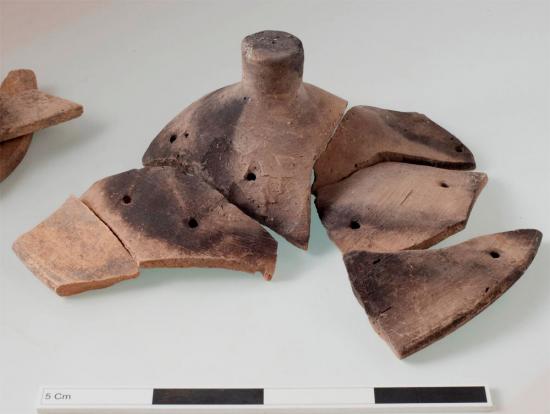Source: University of Wales Trinity Saint David
http://www.pasthorizonspr.com/index.php/archives/05/2014/qatar-coastal-heritage-revealed?
The Wales Qatar Archaeological Project was originally set up in 2010 by archaeologist Dr Andrew Petersen from the University of Wales Trinity Saint David (UWTSD). The project is concerned with the research excavation and survey of a number of coastal sites in northern Qatar.
Currently the university is working on two sites, Ruwaydha and Rubayqa. Preliminary reports on both sites have been published in the Proceedings of the Seminar for Arabian Studies.
Dr Petersen first travelled to Qatar in 2008, a visit which by chance coincided with a decision by the Qatar Museum Authority (QMA) to begin a comprehensive series of archaeological investigations targeting Islamic period sites. This was the catalyst for the creation of the project.
Dr Petersen explained: “On a tour of the archaeological sites in northern Qatar, I was immediately struck by the density of the occupation along the coast and saw the potential of a targeted excavation programme.
Ras ‘Ushairiq
“So far two sites have unearthed a rich history of the State. The excavation of a site called Ras ‘Ushairiq uncovered a large settlement called Rubayaqa which revealed several large courtyard homes, a mosque and two cemeteries.”
Finds from the site were as diverse as iron cannon balls to wooden chess pieces and large quantities of ceramics.

18th century Chinese blue and white porcelain bowl. Image: Wales Qatar Archaeological Project/Qatar Museums Authority

18th century Aali ware cooking pot lid. Image: Wales Qatar Archaeological Project/Qatar Museums Authority
Ruwayda
“A second site called Ruwayda has revealed the remains of a town which was dominated by a large fortress. It includes a mosque complex, workshops, warehouses and a tomb. Other finds, such as ceramics, indicate long-distance trade with nations such as China, southeast Asia, Oman, Iran and India.”
Al-Ruwayda rarely appears in historical sources. It does not, for example, appear on the map made by Captain Brucks in the 1820s. The site is first mentioned in the 1790s when it was one of a number of settlements conquered by the Wahhābī commander Ibrāhīm ibn Ufaysān.
John Gordon Lorimer, the writer of the Gazetteer of the Persian Gulf, Oman and Central Arabia: an encyclopaedic two volume work of colonial intelligence surveying the history and geography of the region at the end of the 19th century is the first to refer to the site as ‘Dōhat al-Ruwaydah’ (i.e. the bay of al-Ruwayda) and describes it as ‘a deserted village three miles above Khor Hassan [al-Khuwayr]’. Lorimer further states that ‘the inhabitants migrated to Zubarah when the latter was founded’.
Three main phases
The first excavations at the site concentrated on the area of the fort in an attempt to understand the sequence and nature of construction. It now appears that it was built in three main phases. In the first phase a small square fort was built with a single round tower at the northwest corner. The date of this early construction is not yet known although it appears to have existed before the eighteenth century when extensive repairs were carried out. In the second phase dating to the early eighteenth century the size of the fortress was more than doubled and had a maximum length of 100 metres per side. However the walls of this larger fortress were fairly thin (less than 80cm wide) and this feeble construction suggests the level of attack that was expected despite the display of strength it tried to present with its large rectangular towers at each corner and in the middle of each wall.
At the northeast corner of the newly enlarged fortress there was a large courtyard house with a portico supported on stone piers. This building has been interpreted as the ruler or governor’s palace and in addition to the rooms ranged around the courtyard also had direct access to the north-east corner tower.
Soon the palace walls of the second phase fortress (18th century) were dismantled and its size was drastically reduced, but the walls doubled in thickness, suggesting a concern with security, perhaps due to raids from the sea. In addition to the fortress a number of other structures within it have been identified and excavated, including a mosque, a series of warehouses and an enigmatic tomb like structure.

Aerial view at Ruwayda. Image: Wales Qatar Archaeological Project/Qatar Museums Authority
The excavations have provided plentiful evidence for long distance trade with ceramics from China, southeast Asia (Burma), Oman, Iran and India. The proportion of East Asian ceramics is particularly high reaching 5% of the total, suggesting both a high standard of living as well as good connections to Indian Ocean trading routes. In addition to ceramics, numerous other types of objects were found including grinding stones, glass, jewellery and metalwork.
State of the art survey
Analysis of the sites have been further enhanced following the award of a Qatar National Research Fund Grant. This has given the Project an opportunity to use an Unmanned Aerial Vehicle (UAV) to carry out survey work. It allows 3D terrain models to be generated and is able to support the creation of high-resolution maps of the sites under investigation. Through the use of on-board sensing systems, such as near infra-red, thermal and various other techniques, the UAV has the potential to identify sub-surface remains.
The advantage of having a high specification UAV like the Microdrone is that it flies using waypoints or predetermined routes controlled by on-board GPS, gyroscope and barometric readings. For example this means that it is able to survey a grid pattern and take a series of photographs at predetermined intervals enabling production of a high resolution total map of the surface of the archaeological site.

Aerial drone survey at Ruwayda. Image: Wales Qatar Archaeological Project/Qatar Museums Authority